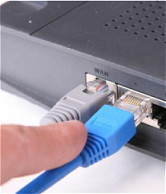Once you’ve decided on the type of Ethernet network that is best 
for your business, it’s time to look at equipment.
Each computer on your network will need a Networking Interface Card (NIC)
or adapter in order to communicate with your hub and each other.
NICs do the work of moving data back and forth.
There are a number of NICs on the market today including USB, PC and PCI cards. The one you select will depend on the equipment residing on your network.
Remember to consider scalability. There are 10/100 NICs on the market today that are a worthwhile investment if you plan to start out with a 10Base-T network with a view to one day upgrading to 100Base-T.
Your hub is the central point of your network joining computers and network equipment like printers together so that they can communicate with each other. Each hub has a number of ports that connect it to the other devices on your network via a network cable.
The smallest hub on the market comes with 4 ports and they go up to 24. When considering a hub, as with any piece of network equipment, don’t forget scalability.
There are a number of ways to interconnect your hubs to facilitate a larger number of devices on your network. If you already have a hub and wish to add another you can do so by a method called uplinking, simply using the last available port on your current hub to connect to the next.
If you’re just starting out and expect growth in the not too distant future, consider a hub with a stacking port on the rear panel that can be used as a connection point. This is an attractive option as it means that you aren’t wasting a port on your hub as with uplinking. Your final option is to link your hubs to a switch, discussed below.
Note that both the hub and the individual computer NICs must be rated at the same speed in order to work properly. The cost of your hub will be affected by the number of ports and its speed, as well as the manufacturer.
The various parts of your network will need to be connected by means of cabling. Ethernet networks typically operate on Unshielded Twisted Pair (UTP) cables that come in a number of grades, with CAT5 being the most popular. CAT5 is short for Category 5 and represents the fifth generation of twisted pair cabling. Cables plug into the individual computers and hubs by means of an RJ-45 connector, similar to the RJ-11 telephone jack.
One factor to consider when installing cabling is the fact that you are limited to 100m or approximately 300ft. when it comes to the length of individual cable segments. An uninterrupted piece of cable become unreliable once this distance has been exceeded and will result in a degradation of performance such as reduced signal strength.
A switch is basically an intelligent hub and is something for you to consider if you are planning a larger network. A switch will manage your network traffic more efficiently than a standard hub, selecting the paths for your data and thus avoiding the data collisions that occur when a hub broadcasts to the network. This offers a considerable boost to your network performance. A switch is commonly used to split networks into smaller units to enhance traffic flow. The hubs then cascade from the switch.
These days routers come in two varieties: network routers and Internet routers. A network router is a piece of equipment that joins a number of networks together and as the name implies routes inter- and intra-office communications. This is something to consider if you are planning a particularly large local area network or are connecting branch offices together in a wide area network.
An Internet router is used to direct traffic between your network and the Internet. Most Internet routers come with a built-in firewall to protect your network against hackers. When considering this equipment make sure you go for one that is easy to configure.
If you’ve decided on a client / server network infrastructure you will need to purchase a server, discussed in detail in the article Server Buying Guide.
If you wish to network your computers you will need a network operating system like Microsoft Windows 2000 Server for your server, and Windows XP for your individual workstations.
If you’re installing a server, you may wish to consider a consolidated network software solution like Microsoft Small Business Server that will provide you with a seamless interface to accomplish your desired networking tasks.
If yours is a small business starting out, with only a few computers that you wish to network, you may wish to consider a starter kit from a manufacturer like NetGear. Such starter kits have been designed with newcomers to networking in mind and provide the essential network components as well as explanatory guides with step-by-step instructions to get you started.
As always, check the warranties on your equipment before signing on the dotted line,
and if your network infrastructure is a complex one make sure that you have access to technical support.
Here is a list of some of the top names in network infrastructure:
• 3Com
• NetGear
• Linksys
• D-Link
• Belkin
Thanks the Techstore Team
